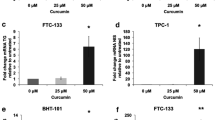Abstract
This study aims to explore the apoptotic function of shikonin on the papillary thyroid cancer cells and the related mechanism. The papillary thyroid cancer cell lines K1 and W3 and thyroid follicular epithelial cells NTHY-ORI 3-1 were treated with different concentrations of shikonin. Cell proliferation was tested. Morphological changes of the apoptotic cells were observed by Hoechst 33342 staining. The apoptosis rate of the papillary thyroid cancer cells was measured with flow cytometry. Changes of the cell cycle were explored. The mitochondrial membrane potential changes were analyzed after JC-1 staining. Bcl-2 family proteins and caspase-3 expression with shikonin treatment was analyzed by real-time fluorescence polymerase chain reaction (PCR). Cell proliferation of K1 and W3 was inhibited by shikonin, and the inhibition was dose–time dependent. Papillary thyroid carcinoma cells treated by shikonin had no obvious cell cycle arrest but were observed with the higher apoptosis rate and the typical apoptotic morphological changes of the cell nucleus. JC-1 staining showed that shikonin reduced the mitochondrial membrane potential of papillary thyroid carcinoma cells. Real-time PCR results showed that shikonin significantly increased Bax and caspase-3 expression and upregulated Bcl-2 expression in a dose-dependent manner in papillary thyroid carcinoma cells. However, the NTHY-ORI 3-1 was almost not affected by shikonin treatment. Shikonin can inhibit K1 and W3 cell proliferation in a dose- and time-dependent manner, enhance Bax levels, reduce anti-apoptotic protein Bcl-2 levels, result in decreasing mitochondrial membrane potential and activating caspase-3 enzyme, and finally lead to apoptosis.





Similar content being viewed by others
References
Aschebrook-Kilfoy B, Ward MH, Sabra MM, Devesa SS. Thyroid cancer incidence patterns in the United States by histologic type, 1992–2006. Thyroid. 2011;21(2):125–34.
Han W, Xie J, Fang Y, Wang Z, Pan H. Nec-1 enhances shikonin-induced apoptosis in leukemia cells by inhibition of RIP-1 and ERK1/2. Int J Mol Sci. 2012;13(6):7212–25.
Gong K, Li W. Shikonin, a Chinese plant-derived naphthoquinone, induces apoptosis in hepatocellular carcinoma cells through reactive oxygen species: a potential new treatment for hepatocellular carcinoma. Free Radic Biol Med. 2011;51(12):2259–71.
Sasi N, Hwang M, Jaboin J, Csiki I, Lu B. Regulated cell death pathways: new twists in modulation of Bcl-2 family function [J]. Mol Cancer Ther. 2009;8(6):1421–9.
Hsu P, Huang Y, Tsai M, Wang YJ, Lin JK, Pan MH. Induction of apoptosis by shikonin through coordinative modulation of the Bcl-2 family, p27, and p53, release of cytochrome c and sequential activation of caspases in human colorectal carcinoma cells. J Agric Food Chem. 2004;52(20):6330–7.
Salvioli S, Ardizzoni A, Franceschi C, Cossarizza A. JC-1, but not DiOC6(3) or rhodamine 123, is a reliable fluorescent probe to assess delta psi changes in intact cells: implications for studies on mitochondrial functionality during apoptosis. FEBS Lett. 1997;411(1):77–82.
Kretschmer N, Rinner B, Deutsch AJ, Lohberger B, Knausz H, Kunert O, et al. Naphthoquinones from Onosma paniculata induce cell-cycle arrest and apoptosis in melanoma cells. J Nat Prod. 2012;75(5):865–9.
Chang IC, Huang YJ, Chiang TI, Yeh CW, Hsu LS. Shikonin induces apoptosis through reactive oxygen species/extracellular signal-regulated kinase pathway in osteosarcoma cells. Biol Pharm Bull. 2010;33(5):816–24.
Fan Y, Jin S, He J, Shao Z, Yan J, Feng T, et al. Effect of β,β-dimethylacrylshikonin on inhibition of human colorectal cancer cell growth in vitro and in vivo. Int J Mol Sci. 2012;13(7):9184–93.
Elumalai P, Gunadharini DN, Senthilkumar K, Banudevi S, Arunkumar R, Benson CS, et al. Induction of apoptosis in human breast cancer cells by nimbolide through extrinsic and intrinsic pathway. Toxicol Lett. 2012;215(2):131–42.
Lu L, Qin A, Huang H, Zhou P, Zhang C, Liu N, et al. Shikonin extracted from medicinal Chinese herbs exerts anti-inflammatory effect via proteasome inhibition. Eur J Pharmacol. 2011;658(2–3):242–7.
Leibowitz B, Yu J. Mitochondrial signaling in cell death via the Bcl-2 family. Cancer Biol Ther. 2010;9(6):417–22.
Abe H, Yoshizaki F. In vitro antifungal activity of naphthoquinone derivatives. Biol Pharm Bull. 2002;25(5):669–70.
Gao H, Liu L, Qu ZY, Wei FX, Wang SQ, Chen G, et al. Anti-adenovirus activities of shikonin, a component of Chinese herbal medicine in vitro. Biol Pharm Bull. 2011;34(2):197–202.
Andújar I, Ríos JL, Giner RM, Recio MC. Shikonin promotes intestinal wound healing in vitro via induction of TGF-β release in IEC-18 cells. Eur J Pharm Sci. 2013;49(4):637–41.
Kontogiannopoulos KN, Assimopoulou AN, Hatziantoniou S, Karatasos K, Demetzos C, Papageorgiou VP. Chimeric advanced drug delivery nano systems (chi-aDDnSs) for shikonin combining dendritic and liposomal technology. Int J Phann. 2012;422(1–2):381–9.
Yin SY, Peng AP, Huang LT, Wang YT, Lan CW, Yang NS. The phytochemical shikonin stimulates epithelial-mesenchymal transition (EMT) in skin wound healing. Evid Based Complement Alternat Med. 2013;2013:262796.
Sankawa U, Ebizuka Y, Miyazaki T, Isomura Y, Otsuka H. Antitumor activity of shikonin and its derivatives. Chem Pharm Bull (Tokyo). 1977;25(9):2392–5.
Sankawa U, Otsuka H, Kataoka Y, Iitaka Y, Hoshi A, Kuretani K. Antitumor activity of shikonin, alkannin and their derivatives. II. X-ray analysis of cyclo-alkannin leucoacetate, tautomerism of alkannin and cyclo-alkannin and antitumor activity of alkannin derivatives. Chem Pharm Bull (Tokyo). 1981;29(1):116–2.
Acknowledgments
This study was supported by the grants from the Zhejiang Natural Science Foundation (Y2100248), Foundation of Department of Science and Technology of Zhejiang Province (2009C33155), Foundation of Zhejiang Health Department (2009A218), Taizhou Science and Technology Bureau (102KY15), and Zhejiang Province Chinese Medicine Study Foundation (2011ZA113).
Conflicts of interest
None
Author information
Authors and Affiliations
Corresponding author
Additional information
The Publisher and Editor retract this article in accordance with the recommendations of the Committee on Publication Ethics (COPE). After a thorough investigation we have strong reason to believe that the peer review process was compromised.
An erratum to this article can be found online at http://dx.doi.org/10.1007/s13277-017-5487-6.
Chibo Liu and Jiayu Chen contributed equally to this work.
About this article
Cite this article
Liu, C., Yin, L., Chen, J. et al. RETRACTED ARTICLE: The apoptotic effect of shikonin on human papillary thyroid carcinoma cells through mitochondrial pathway. Tumor Biol. 35, 1791–1798 (2014). https://doi.org/10.1007/s13277-013-1238-5
Received:
Accepted:
Published:
Issue Date:
DOI: https://doi.org/10.1007/s13277-013-1238-5




